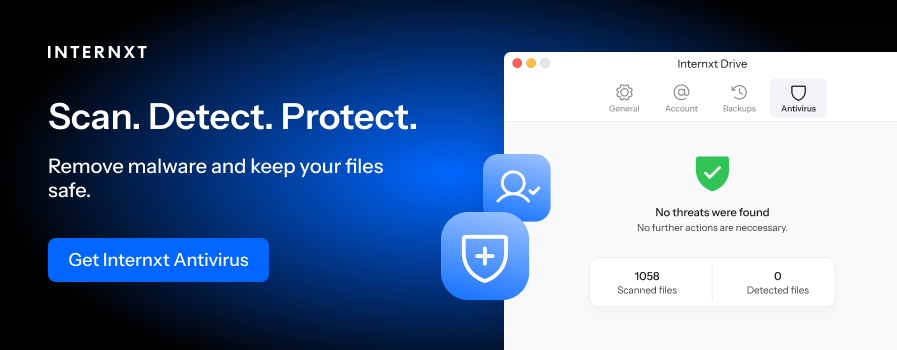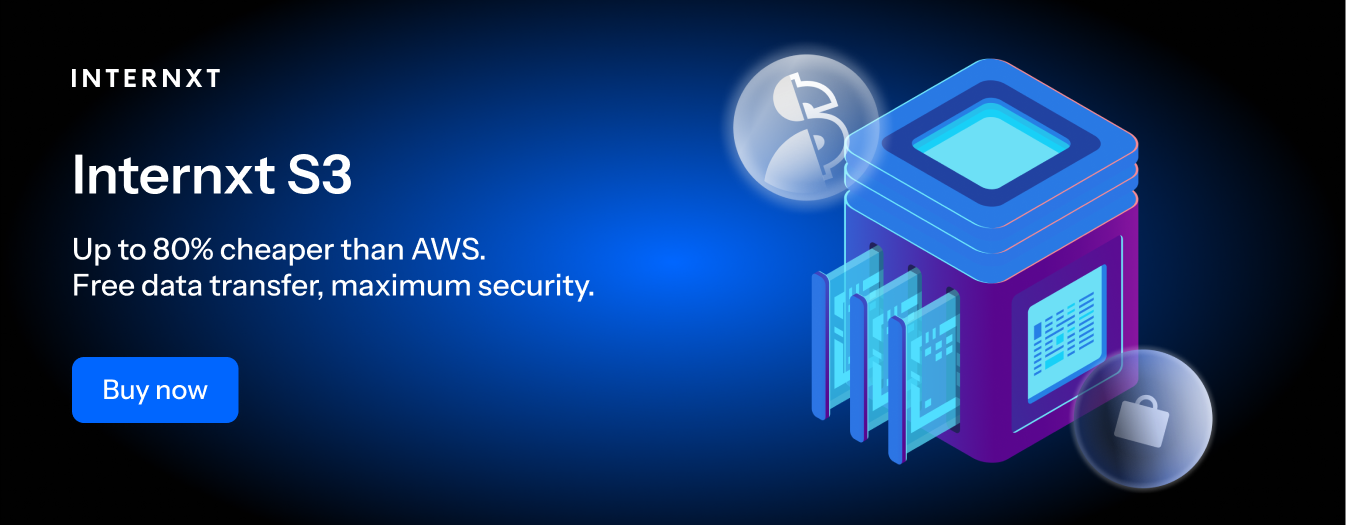Top Fraud Trends Of 2025 And How To Prevent Them

Online fraud is, unfortunately, becoming a lucrative business for cybercriminals, hackers, and scammers. It’s now easier than ever to use AI to help generate phishing emails, and people can even use fraud-as-a-service to buy pre-made malware to target and steal our financial and business information.
This article will cover the top fraud trends and statistics growing in popularity, and how your business can protect itself using secure and private services like Internxt a GDPR compliant company with a mission of helping businesses and individuals gain a more private life online, free from data breaches and unethical data collection.
- Top fraud trends statistics
- Top Fraud trends that threaten our data
- How to protect your data from the top fraud trends
- How to protect against the top fraud trends with Internxt
Top fraud trends statistics
Here are some statistics taken from various sources to highlight the importance of protecting ourselves, our businesses, and our customers from the top fraud trends that pose a risk to our data.
- Europe faces the most significant e-commerce fraud risk, with Germany and France facing the biggest hits.
- 42% of e-commerce fraud happens in North America, which has the highest fraudulent transaction value globally.
- It’s predicted that the cumulative losses to online payment fraud globally between now and 2027 will exceed $343 billion.
- 25% of financial organizations reported $1M in fraud losses,
- By 2027, advances in Gen AI will cost banks an estimated $40 billion.
- Bust-out fraud, app fraud, and account takeover fraud are the most common fraud types reported by banks and fintechs.
Top Fraud trends that threaten our data
AI fraud and deepfakes
AI has become an innovative tool for many, but it also brings with it many problems such as data collection or misuse, spreading false information, and being used to carry out some of the top fraud trends of the year, such as AI phishing emails, voice cloning, and audio deepfakes.
While governments, businesses, and employees are trying to keep up with and introduce new forms of preventing AI scams, these fraudsters are equally as quick to adapt.
Fraud-as-a-service
Fraud-as-a-Service is one of the top fraud trends, and it’s a service where professional fraudsters provide the tools required for individuals who don’t have the knowledge to commit these frauds themselves.
These tools include:
- Phishing kits are pre-packaged tools to create fake websites or emails that impersonal companies such as Apple, Amazon, PayPal, or more advanced kits to bypass multi-factor or 2FA tools.
- Malware software to infiltrate systems and steal financial information from financial institutions.
- Botnets can be used to send spam email with malicious links or attachments, and they can also be a system of infected devices that are part of a larger network that can be controlled externally by an attacker.
Due to the increase of fraud-as-a-service, the top fraud trends of the past few years are becoming increasingly more accessible and dangerous to businesses and consumers.
Account takeover (ATO) fraud
Account takeover fraud happens when a cybercriminal or scammer gains access to an account email or password from a malicious link or malware. Common accounts include bank accounts, email, and social media accounts.

Once the account is hacked, the attacker will drain funds, make unauthorized transactions, and block the original owner of the account by changing the password, email, or phone number.
eID and digital wallets
eID and digital wallets are becoming one of the top fraud trends as we are all ditching our physical cards for Apple Pay, Google Pay, etc. Although these are more convenient, potentially more secure, they come with more risks if the necessary security measures aren’t taken.
This kind of fraud happens when a user’s wallet is compromised due to weak passwords and can sometimes register a new wallet on their own device and make unauthorized transactions.
Synthetic identity fraud
Synthetic fraud is becoming one of the top fraud trends of 2025 due to its complex nature for institutions to identify.
Unlike traditional identity theft, which steals data from a real person, synthetic identity fraud combines real data found in data breaches, public records, or elsewhere, and combines this with fake information to create what appears to be a legitimate identity.
These identities appear to be genuine to financial institutions, but it doesn’t belong to a real person, even if parts of them are real, making the fraud even more difficult to detect.
Synthetic fraud has a significant impact on consumers and businesses. A scammer may use the social security number of a young child to build a false identity, impacting their credit score which they may not know about until they apply for a loan.
In the first half of 2024, U.S. lenders faced a record $3.2 billion in potential losses due to synthetic identity fraud, with online crypto exchanges and online lending and payment services being the most affected.
OSINT fraud attacks
Fraudsters are increasingly using open-source intelligence (OSINT) fraud attacks to use public data taken from social media profiles or breached credentials to craft personalized phishing and social engineering attacks, such as pretexting.
By using this data and information from profiles such as LinkedIn, fraudsters can craft personalized phishing emails to target high-level corporate workers to try and steal personal client or financial information.
How to protect your data from the top fraud trends
Financial regulations
Fortunately, there are a few regulatory bodies that set guidelines for financial institutions to protect user data, prevent top fraud trends, and offer recommendations to keep financial data secure.

In the EU, the Digital Operational Resilience Act (DORA regulation) applies to all financial institutions and third-party providers to mitigate the risks of ransomware, malware and spyware, data breaches, or service disruptions and financial fraud.
You can learn more about how this act aims to protect businesses in our DORA blog article.
In the US, industries such as the NIST and FINRA aim to guide businesses to identify and mitigate the risks of financial fraud.
AI-focused regulations
As we previously mentioned, the rise of AI scams is forcing governments to implement and adapt regulations designed to help protect businesses and consumers from the top fraud trends mentioned in this article.
The European Union AI Act is the world’s first introduction and comprehensive regulation regarding AI. It categorizes AI apps based on their risk levels and the requirements needed to mitigate the dangers of high-risk AI with biometric identification to avoid legal and compliance fines.
How to protect against the top fraud trends with Internxt
Internxt Drive & S3
Internxt Drive offers personal and business plans that protect data using post-quantum cryptography alongside zero-knowledge encryption. With this advanced data protection, all files remain private thanks to the encryption keys being managed on your device, so nobody except you can access confidential information.
Internxt Drive also comes with additional measures such as password protection for shared files, and as a GDPR compliant company, Internxt ensures that all user data is handled securely while maintaining privacy.

You can get started with Internxt for just €3 a month and choose from personal annual or lifetime plans, or monthly or annual business plans.
If you need to store large amounts of data, Internxt also offers S3 object storage, a 100% hot cloud solution designed for businesses to instantly access and manage large-scale data.
It’s a pay-as-you-go service for your business to easily scale data at a fixed rate of €7/TB/month, with no additional egress fees to help effectively manage your storage budget.
Visit our website for more information or to get in touch with our sales team to help you get all the storage you need to keep sensitive data protected.
Internxt VPN and Antivirus
Included with Internxt Drive plans include an encrypted VPN to protect your network from network attacks, and an antivirus to protect and delete malware from your device.

These features of Internxt help protect you from financial fraud by keeping data encrypted and protected from hackers, and eliminating harmful malware from your device, which could compromise your files or give criminals access to sensitive information.
Internxt Mail and Meet
In the next few months, Internxt Ultimate plans will include Mail and Meet. Mail is a fully private and encrypted email, designed to keep your communications secure and help protect your accounts from phishing and data breaches.
Meet will be a secure video-conferencing platform, so you can meet with clients and employees online in total privacy to ensure your communications remain private.
Password protection
To keep your accounts secure, Internxt also offers a password and passphrase generator, allowing you to protect your accounts from unauthorized access and account takeovers. To ensure the security of your passwords, you can also check the password strength using Internxt’s password checker
Two-factor authentication
To add even more security to your accounts, it’s crucial to set up two-factor or other kinds of multi-factor authentication for your accounts. These can include a one-use code sent to your device or biometric authentication, such as a fingerprint or face ID.
Monitor accounts regularly
Finally, monitor your system's security protocols and accounts for unusual activity. Some fraud crimes start with small transactions that you may not notice, so monitoring your account regularly will help spot irregularities.
If you spot unauthorized or suspicious activity, you should report the fraud, change passwords, block cards, and take the necessary measures to respond to financial fraud in accordance with the compliance laws that apply to your business.

